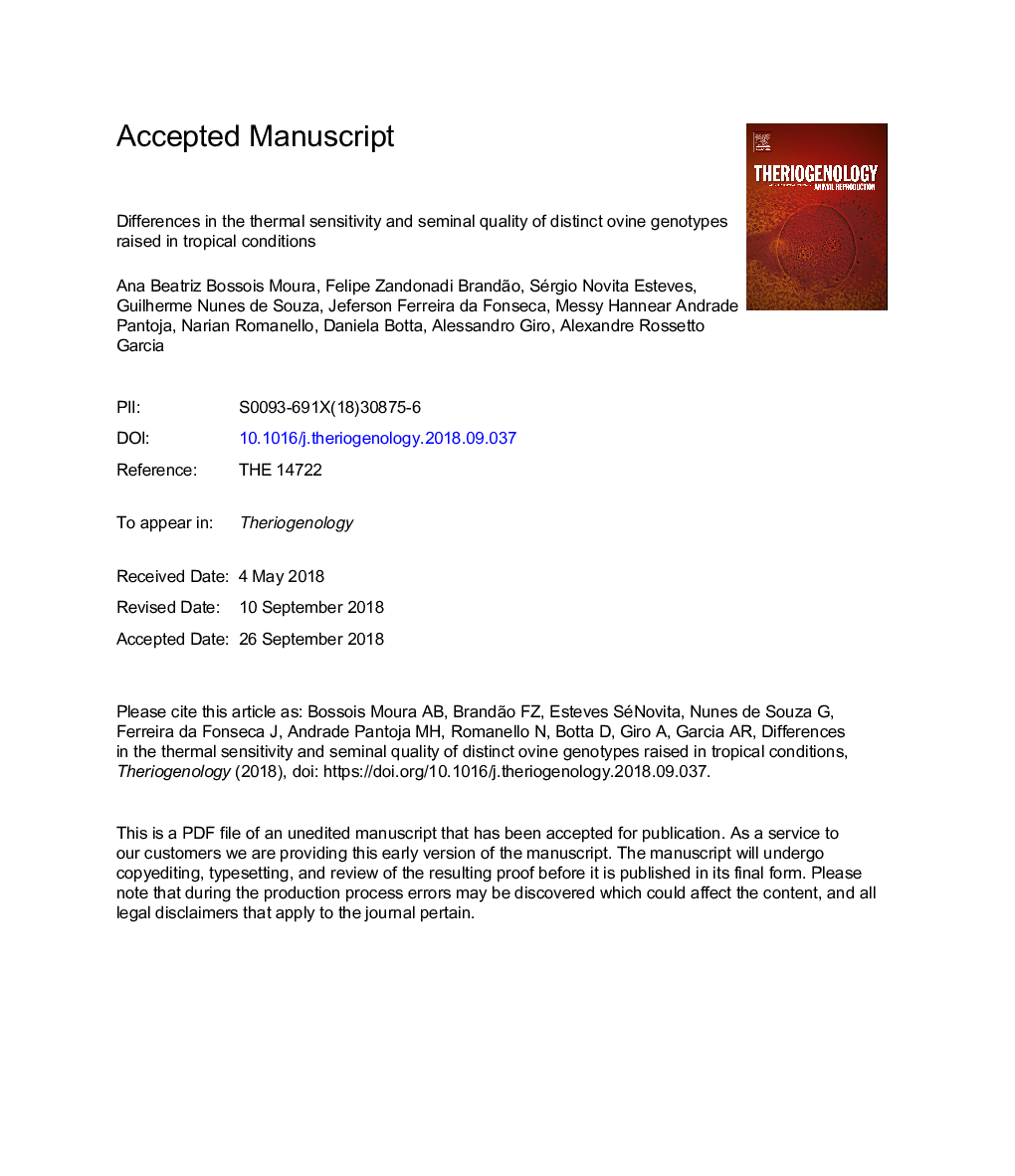| کد مقاله | کد نشریه | سال انتشار | مقاله انگلیسی | نسخه تمام متن |
|---|---|---|---|---|
| 11025957 | 1666464 | 2019 | 27 صفحه PDF | دانلود رایگان |
عنوان انگلیسی مقاله ISI
Differences in the thermal sensitivity and seminal quality of distinct ovine genotypes raised in tropical conditions
ترجمه فارسی عنوان
تفاوت در حساسیت حرارتی و کیفیت ذاتی ژنوتیپ های مختلف تخم مرغ در شرایط گرمسیری
دانلود مقاله + سفارش ترجمه
دانلود مقاله ISI انگلیسی
رایگان برای ایرانیان
موضوعات مرتبط
علوم زیستی و بیوفناوری
علوم کشاورزی و بیولوژیک
علوم دامی و جانورشناسی
چکیده انگلیسی
For different ovine breeds to maximize their reproductive capacity in countries with tropical climate, it is important to evaluate their potential for thermal resilience and consequences on their reproductive traits. Therefore, the objective of this study was to evaluate the effect of thermal environment temperatures of climate seasons in a tropical climate region on the surface temperatures of the scrotum, testicular biometric characteristics, seminal quality and serum testosterone concentration of rams of different genotypes. Breeders of four different genotypes (Dorper, nâ¯=â¯8, Texel, nâ¯=â¯8, Santa Inês, nâ¯=â¯9 and Morada Nova, nâ¯=â¯8) were used throughout the four climate seasons. Higher thermal challenge was recorded in the spring and summer. In the summer increase in scrotal surface temperature was detected by infrared thermography (Pâ¯<â¯0.05), mainly in the regions of the distal testicular pole and tail of the epididymis. The animals of the Texel genotype had higher rectal temperature in the summer. In spring, this genotype also had the highest testicular pole (32.2â¯Â±â¯0.5â¯Â°C; Pâ¯<â¯0.05) and distal (29.9â¯Â±â¯0.4â¯Â°C; Pâ¯<â¯0.05) temperatures and a higher mean testicular temperature (31.7â¯Â±â¯0.4â¯Â°C; Pâ¯<â¯0.05). The Morada Nova genotype showed a higher surface temperature gradient between testicular poles (2.96â¯Â±â¯0.1â¯Â°C; Pâ¯<â¯0.05), especially in spring. Genotype-dependent thermal sensitivity was detected for the thermal gradient between the testicular poles, reflecting the seminal quality. There was a positive correlation of the thermal gradient between testicular poles with sperm membrane integrity and negative correlation with total sperm defects. The Texel genotype showed less progressive motility and higher percentage of sperm defects. There was no difference in testosterone concentration between genotypes and in the different seasons (Pâ¯>â¯0.05). Thus, the indigenous genotypes showed a greater capability to maintain the scrotum-testicular thermoregulation. Dorper animals resembled the indigenous sheep genotypes, in terms of seminal characteristics, unlike Texel animals, which showed lower adaptability and lower seminal quality.
ناشر
Database: Elsevier - ScienceDirect (ساینس دایرکت)
Journal: Theriogenology - Volume 123, 1 January 2019, Pages 123-131
Journal: Theriogenology - Volume 123, 1 January 2019, Pages 123-131
نویسندگان
Ana Beatriz Bossois Moura, Felipe Zandonadi Brandão, Sérgio Novita Esteves, Guilherme Nunes de Souza, Jeferson Ferreira da Fonseca, Messy Hannear Andrade Pantoja, Narian Romanello, Daniela Botta, Alessandro Giro, Alexandre Rossetto Garcia,
